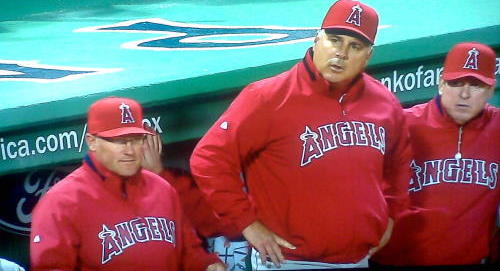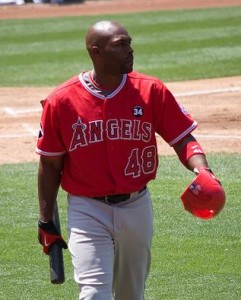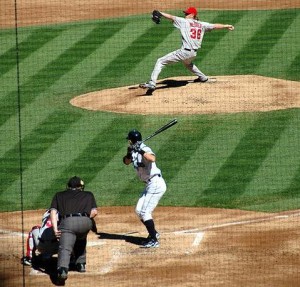Via Keith Law, high school right-hander Tyler Beede has sent a letter to area scouts informing them that he plans on following through on his commitment to Vanderbilt. High school outfielder Josh Bell did something similar. Beede, who I wrote about a few weeks ago, is a first round arm and this is just a way of building leverage in neogitations. Someone will still draft him high, but anything that could cause him to slide in the draft is good news for the Yankees.
Friday Open Thread
The game thread will be along a little while later, so bide your time here. The Mets are on, Game Two of the Stanley Cup Finals are, plus some other stuff. Go nuts.
Oh, Don’t Bring In The Lefty looked at the Yankees’ first pitch swinging data this afternoon, in response to this morning’s mailbag question. Unsurprisingly, Robinson Cano tops the list.
2011 Draft: Keith Law’s Mock Draft v3.0
Keith Law’s latest mock draft hit the interwebs today (Insider req’d), and he still has the Pirates taking UCLA RHP Gerrit Cole first overall. Rice 3B Anthony Rendon is going second to the Mariners, and he now has UCLA RHP Trevor Bauer going to the Diamondbacks at three. Klaw says that high school lefty Daniel Norris is looking for Tyler Matzek money ($3.9M), and Kevin Goldstein added some more bonus demands on Twitter. We’ve already heard about Josh Bell telling teams he doesn’t want to turn pro as well as the ridiculous bonus demands of Dylan Bundy and Archie Bradley.
2011 Draft: Joe Ross
The draft is just three days away, so between now and then I’m going to highlight some players individually rather than lump a few together in one post.
Joe Ross | RHP
Background
The brother of Oakland A’s right-hander Tyson Ross, Joe attends Bishop O’Dowd High School in Oakland just like his brother did a few years ago. He’s a very good student with a strong commitment to UCLA.
Scouting Report
Unlike Tyson, Joe is much more conventional. His delivery and arm action are clean, and he gets good downhill plane from his 6-foot-2, 180 lb. frame. Ross’ fastball typically sits 90-94 mph with some armside run, but he ran it up as high as 96 this spring and there’s reason to believe there’s even more velocity coming with that frame. His breaking ball is more of a curveball but occasionally it morphs into a slider. When right, the pitch is delivered in the high-70’s with some horizontal break to go along with the downward action. Ross also throws a low-80’s changeup. He’s a very good athlete and it’s easy to project three better than average pitches down the line given what he has right now.
Miscellany
Ross doesn’t project as a true ace, but instead a notch below that and there’s ain’t nothing wrong with that at all. The commitment to UCLA and presumably high price tag would have to work in the Yankees favor if they want to have a chance at him with the 51st overall pick. Keith Law and Baseball America considered Ross the 25th and 36th best prospect in the draft in their latest rankings, so he’s a legit first round talent.
Series Preview: Anaheim Angels

There once was a time when the Yankees simply could not beat the Angels. They were just 28-36 against the Halos from 2002 through 2008, but then things changed in 2009. After getting swept in Anaheim right before the 2009 All-Star break, the Yankees went on a big second half run that includes three wins in four regular season games against the Angels, and of course the four games to two series win in the ALDS. It’s been smooth sailing against Mike Scioscia’s fading club ever since.
What Have The Angels Done Lately?
Coming off two straight losses to the Royals, the Angels have won just lost eight of their last 13 games to push their record to 29-29. They do have a positive run different at +3, but for all intents and purposes it indicates that they are exactly what their record suggests they are: a .500 club.
Angels On Offense

There’s one thing the Angels really lack on offense, and it’s power. As a team, they have just a .133 ISO and 49 homers, both good for tenth place in the American League. The lack of pop is even more noticeable with both Kendrys Morales and Vernon Wells on the disabled list. When Scioscia fills out his lineup card tonight, he’s going to have just two players with more than three long balls at his disposal: Torii Hunter (eight) and Mark Trumbo (ten). The Yankees, on the the other hand, have just one regular (Derek Jeter) with fewer than three homers.
In addition to Morales and Wells, the Halos are also without second baseman Howie Kendrick, who a) kills the Yankees (.371/.441/.481), and b) has been one of the best hitters in baseball this season (.322/.388/.520). It sounds like they might be able to activate him off the disabled list in time for Saturday’s game, however. Their best hitter aside from Kendrick has been Erik Aybar, who sports a .315/.356/.444 line with 14 steals out of the leadoff spot. Maicer Izturis (.285/.354/.414) is the only other regular with both a .310+ OBP and a .400+ SLG. Yep.
Old buddy Bobby Abreu is still doing the on base thing (.388 OBP) and stealing bases (eight), but his power is completely gone (.097 ISO). Hunter’s season line sits at .242/.325/.397, and Alberto Callaspo’s line is a lot like Abreu’s (.299/.371/.388). Trumbo, the rookie first baseman filling Morales’ shoes, is at .255/.305/.467 on the year but .320/.346/.680 over the last two weeks or so. He’ll get himself out on stuff off the plate, but don’t miss in the zone. Another rookie, Hank Conger, has done a decent job of taking playing time away from the certifiably awful Jeff Mathis, but he’s still at .234/.287/.364. The Angels recently picked up Russell Branyan to add some pop, but he wasn’t hitting with the Diamondbacks (.284 wOBA) and has done next to nothing (.095 wOBA) in seven games with Anaheim.
Like Justin Turner a few weeks ago, my pick to annoy the everliving hell out of the Yankees with weekend is Peter Bourjos. The rookie center fielder might be the best defensive outfielder in the game right now, and if you don’t believe me just check out his video highlights on MLB.com. Bourjos is only hitting .236/.292/.382 on the year, but don’t let that fool you. He has some pop and can run, and will do all the little things to annoy the crap out of you in this series. I guarantee he’ll hit at least one triple in these three games. It’s inevitable.
Angels On The Mound

Friday, RHP Jered Weaver: The Yankees have been facing great pitchers all road trip, so there’s no point in stopping now. Jeff’s younger brother is sporting a 2.48 FIP through a dozen starts this year, striking out more than eight men while walking just over two for every nine innings pitched. He is a fly ball pitcher (37.3% grounders) but he has pretty considerable reverse split over the last two years because his changeup is really good. All those lefty bats – Curtis Granderson, Robinson Cano, and switch hitters Mark Teixeira and Nick Swisher – are going to have to watch out for it. Weaver also throws four and two-seam fastballs right around 90 mph, and his out pitch is a slider in the upper-70’s. He’ll also bust out a curveball from time to time. I suppose the good news is that he’s cooled off after a scorching start, but he still sports at 3.18 ERA in his last five outings. Don’t hate on him for being a Weaver, Jered’s as good as it gets. But this is the third series in a row we’re writing this.
Saturday, RHP Dan Haren: As of this writing, it’s unclear if Haren will even make this start. He had to cut Thursday’s regular bullpen short because of back pain, and the Angels have yet to provide an update. I assume he’s still starting in that case. Anyway, Haren is in the middle of the best year in his career, rocking a 2.54 FIP on the strength of his always stingy walk rate (1.46 BB/9) and a strong homerun rate (0.52 HR/9) that comes from his best ground ball rate (44.6%) in years. He pounds the zone with two and four-seamers around 90 mph, a cutter in the mid-80’s, and then finishes batters off with a splitter around 90 and the occasional changeup or curveball. Only twice this year has he allowed more than three earned runs in a start, and only four times has he allowed more than two earned runs.
Sunday, RHP Ervin Santana: I have this weird disconnect between what I think Santana is and what he really is. He has a 5.55 ERA and a 5.94 FIP in ten career starts against the Yankees, but for whatever reason it’s stuck in my head that he always pitches well against them. It’s probably just me. Anyway, Santana has a respectable 3.81 ERA in 12 starts this season, and he’s actually sporting his best peripherals (7.75 K/9 and 2.47 BB/9) since 2008. The good news is that he’s allowed no fewer than four runs in six of his last nine starts, including four games of five or more runs. Looking at the PitchFX data, Santana’s just a two pitch pitcher these days. He throws his low-90’s fastball more than 60% of the time and his low-80’s slider more than 36% of the time. The other four percent or so is a changeup, but the usage of that pitch has continually decreased over the last few seasons. If Ervin’s going to come after the Yankees with just a fastball and a slider, well that’s just not a fight he’s going to win.
If Haren does not start on Saturday, the Angels will likely just move Santana up a day. He’d make that on regular rest because they had Thursday off. That would then put Joel Pineiro in line for Sunday’s start. The sinkerball extraordinaire missed the start of the season with a shoulder issue, but he’s posted a 3.55 ERA in seven starts since coming back, relying on his usual combination of no free baserunners (1.57 BB/9) and a healthy amount of grounders (52.3%).
Bullpen: Long gone are the days of Scot Shields crushing souls for two innings in front of Francisco Rodriguez, these Angels certainly feature a good ol’ fashioned lolpen. Their 4.28 FIP is fifth worst in all of baseball, and their 3.67 ERA would be a lot worse if not for a 77.4% strand rate. A 6.85 K/9 and 4.45 BB/9 are both bottom six marks in baseball.
Rookie closer Jordan Walden is legit, with an upper-90’s fastball and wipeout breaking ball, but he also walks 4.62 batters for every nine innings. Fernando Rodney walks two guys for every three innings pitched, and Scott Downs has suddenly forgotten how to strike people out (3.71 K/9). At least he has a 60% ground ball rate to get by with. Kevin Jepsen has walked seven and struck out four in ten innings, and Hisanori Takahashi is amazingly homer prone (1.62 HR/9). Long man Trevor Bell is another sub-4.00 K/9 guy (3.86, to be exact), but the secret weapon is Rich Thompson. The right-hander has struck out 9.99 batters per nine innings while keeping the walks down below three per nine. He’s legit, as is Walden, but everyone else is pretty sketchy.
Recommended Angels Reading: True Grich

Replacing Nunez to strengthen the lineup
The 2011 Yankees have a number of flaws, but the bench isn’t one of them. At the start of the season they featured their deepest bench in years, and even with Eric Chavez on the DL they still have a quality cast of reserves. Once Chavez returns they’ll have that killer bench back and can focus on improving the weaker aspects of the team. Of course, the preceding statement makes two assumptions: 1) That Chavez makes it back in the next few weeks, and 2) That he stays healthy after returning. As anyone familiar with Chavez’s injury history knows, neither is a guarantee.
While there’s nothing wrong with using Chris Dickerson, or even Justin Maxwell, to fill Chavez’s bench spot, it does create a somewhat less flexible situation. Currently, Eduardo Nunez is getting a good helping of starts against left-handed pitching, while either Alex Rodriguez or Derek Jeter takes a half day off at DH. This isn’t a bad idea by any means; both Jeter and A-Rod could use the breather, and it’s hardly a bad idea to play Nunez against opposite-handed pitching. Still, he’s not the ideal guy to be taking all those at-bats.
At Pinstriped Bible, Steven Goldman discussed the “self-defeating” Nunez and his role on the team. One of this lines a bit further down in the article caught my attention: “‘Hard-hitting reserve infielder’ is almost an automatic contradiction in terms.” This is an argument that I often raise when defending a weak Yankees bench. There aren’t many quality reserves to begin with. Why would one of them want to play behind Alex Rodriguez, Robinson Cano, and Derek Jeter? That leaves the Yankees two avenues for finding quality bench players: trades and development. While I applaud the development angle with Nunez, they might find some success when looking outside the organization.
Yesterday Mike looked at the possibility of a Jose Reyes trade. Of course, when you trade for Jose Reyes he’s a starter, and the Yankees already have a starting shortstop. He might not be the best offensively, and he might be a shell of his former self at the plate, but it’s not as though the Yankees can simply trade for a shortstop and replace him. But what if they were to trade for a lesser infielder — someone who can give both A-Rod and Jeter days at DH, while taking a late-inning defensive role? There is one possibly available player for that.
The Dodgers, under .500 and in a tough financial situation, probably want to trim a sizable portion of their $120 million payroll. No one on the team makes more this year than Rafael Furcal. The Dodgers would help their situation by trading him and what remains of his $13 million 2011 salary. Not many teams would be willing to eat that kind of money for a mid-season acquisition, but the Yankees aren’t like other teams. They figure to have a good chunk of spare change set aside for deadline acquisitions. While pitching is the priority, they could do worse than picking up Furcal to help keep Jeter and A-Rod fresh through the second half.
At this point, Furcal’s stat sheet is a bit misleading. He got off to a slow start, though that easily could have been injury related. He returned at the end of May, and has heated up in his past few games, going 8 for his last 17 with a homer. If he rebounds to produce something resembling his normal numbers, he’ll be of much better use than Nunez in the backup infield role. And, if worse comes to worst, he’s a much better full-time fill-in.
(As a bonus, perhaps taking on Furcal could open an opportunity for the Yankees to also acquire the Dodgers second highest paid player, Hiroki Kuroda. But that’s the subject of a different post.)
Perhaps spending $6 million on a backup infielder isn’t the best use of the Yankees’ resources. They have other areas they can improve, and they don’t have an infinite pool of money. But I’m presuming that, because of the off-season disagreement over Rafael Soriano, that Cashman has a little more wiggle room than he would have otherwise. Furcal certainly isn’t the first choice; he’s probably not in the top five. He’s more of the deadline-day, nothing else has panned out kind of move. Yet his bat and his glove can provide some benefit to the Yankees’ lineup. With a Dodgers team likely to sell at a low cost in prospects, he’s someone the Yanks should keep their eyes on, if only as Plan Z.